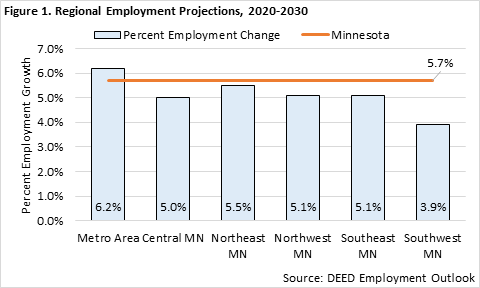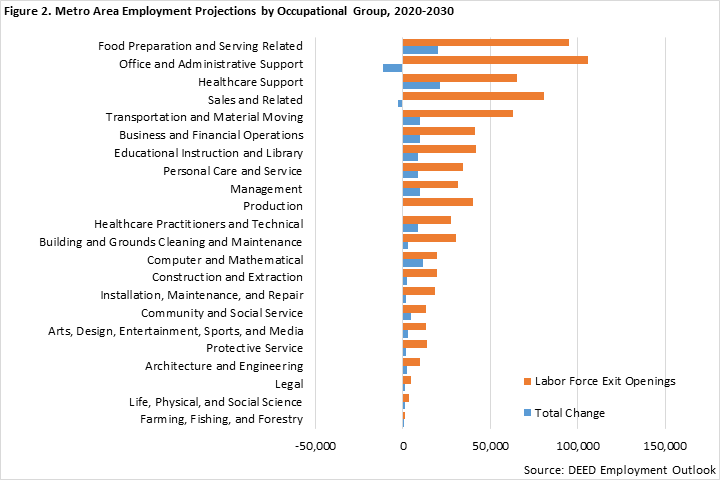 The Minneapolis-St. Paul metropolitan area is a national leader in finance, advanced manufacturing, agriculture and retailing.
The Minneapolis-St. Paul metropolitan area is a national leader in finance, advanced manufacturing, agriculture and retailing.
Medical devices, electronics and processed foods are strong suits recognized globally.
Want the freshest data delivered by email? Subscribe to our regional newsletters.
9/8/2022 9:00:00 AM
Tim O'Neill
 Freshly updated employment projections showcase anticipated growth in the Seven-County Twin Cities Metro Area. More specifically, the Metro Area's total employment is projected to increase by 6.2% between 2020 and 2030, leading all other regional planning areas in Minnesota for growth (Figure 1).
Freshly updated employment projections showcase anticipated growth in the Seven-County Twin Cities Metro Area. More specifically, the Metro Area's total employment is projected to increase by 6.2% between 2020 and 2030, leading all other regional planning areas in Minnesota for growth (Figure 1).
Due to the severe job losses suffered during the pandemic recession, some of this growth is still related to recovery, but the region is still expected to see rapid employment growth in the future. This 6.2% growth is equivalent to nearly 113,300 net new jobs, as the region will increase from 1,817,300 estimated jobs in 2020 to 1,930,600 projected jobs in 2030. The Metro Area's projected net employment growth represents fully two-thirds of the state's total projected employment growth through 2030.

Zooming in, those occupational groups anticipated to witness the most rapid growth in the Metro Area include Healthcare Support (+21.8%), Food Preparation & Serving Related (+17.5%), Personal Care & Service (+16.6%), Computer & Mathematical (+13.0%), and Community & Social Service occupations (+11.7%). Out of 22 major occupational groups, these five rapidly growing groups will account for over half (57.6%) of the region's net new jobs. The Healthcare Support occupational group is projected to have over 21,000 net new jobs alone, with Food Preparation & Serving Related projected to have nearly 20,000 net new jobs.
Beyond net employment growth, DEED's Employment Outlook data also reveals labor force exit openings. These openings represent the projected number of workers leaving an occupation and exiting the labor market entirely, with most such exits related to workers retiring. Between 2020 and 2030, DEED projects over 773,000 labor force exit openings in the Metro Area.
While most occupational groups won't witness the significant net new growth that Healthcare Support and Food Preparation & Serving Related occupations will, nearly every occupational group will witness significant labor force exit openings. Even those occupational groups anticipated to decline in net employment size through 2030 (Office & Administrative Support, Sales & Related, and Production) will witness significant labor force exit openings. This will translate to a high demand for workers in nearly every occupational group through 2030.
Zooming in even further, those specific occupations projected to have the most net new jobs through 2030 in the Metro Area include Software Developers & Software Quality Assurance Analysts (+7,100 jobs); Restaurant Cooks (+5,700 jobs); Fast Food & Counter Workers (+5,000 jobs); Waiters & Waitresses (+3,100 jobs); Market Research Analysts & Marketing Specialists (+2,700 jobs); Registered Nurses (+2,600 jobs); Passenger Vehicle Drivers (+2,300 jobs); General & Operations Managers (+2,000 jobs); Bartenders (+2,000 jobs); and Management Analysts (+2,000 jobs).
DEED's 10-year employment forecasts are updated every other year and can be found online at http://mn.gov/deed/eo.
Contact Tim O'Neill, Labor Market Analyst.